Free Areas of the Alhambra - Places with Entry Without Tickets
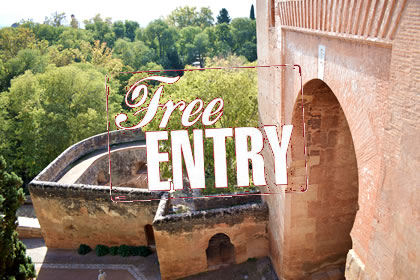

Enjoy a special day at the Alhambra with a guided tour
 Alhambra and Nasrid Palaces: discover the wonders of the Alhambra with this all-inclusive tour: the Nasrid Palaces, the Generalife, the Alcazaba, and more.
Alhambra and Nasrid Palaces: discover the wonders of the Alhambra with this all-inclusive tour: the Nasrid Palaces, the Generalife, the Alcazaba, and more.
 Alhambra + Albaicín + Sacromonte: a perfect combination of a guided tour of the Alhambra in the morning and a guided tour of the Albaicin and Sacromonte in the afternoon.
Alhambra + Albaicín + Sacromonte: a perfect combination of a guided tour of the Alhambra in the morning and a guided tour of the Albaicin and Sacromonte in the afternoon.To visit the Nasrid palaces (the most beautiful and famous part), the Alcazaba (military buildings and towers) and the Generalife (palaces and gardens) you need to purchse a ticket.
In this section, you will find information about the attractions you can visit in the Alcazaba free of charge. Don't underestimate it just because it's free; there are very interesting places waiting to be discovered.
There is no better way to explore the Alhambra than with a tour guide
Alhambra Guided Tour: a top-rated guided tour led by a knowledgeable local historian will definitely add a special touch to your visit. Includes access to all areas.
Alhambra + Albaicín + Sacromonte Tour: or, for just a little bit more, uncover the wonders of the Alhambra, alongside 2 picturesque neighborhoods of Granada.
The Pomegranates Gate
If you walk from Plaza Nueva to Cuesta Gomérez you come across the impressive Puerta de las Granadas (Gate of the Pomegranates). This beautifully preserved medieval gate serves as the main entrance to the the Alhambra forest.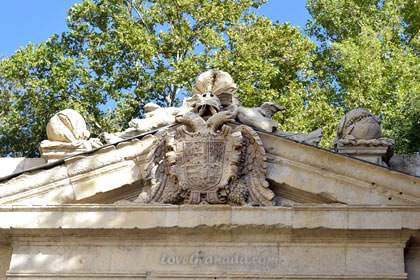 The Pomegranates Gate (pictured) was constructed in 1536 to replace a previous gate known as Bib-Albuxar
(gate of the good news). Some remnants of this door are still visible on the right side of the current gate.
The Pomegranates Gate (pictured) was constructed in 1536 to replace a previous gate known as Bib-Albuxar
(gate of the good news). Some remnants of this door are still visible on the right side of the current gate.
The pomegranate, which is the symbol of Granada, is depicted in carvings on this gate, hence its name.
Right on the center ,you can see the Imperial coat of arms of Emperor Charles V, which is crowned by three grenades.
The gate consists of three arches: a central one for cavalry; and two lateral ones for people.
The Alhambra Forest
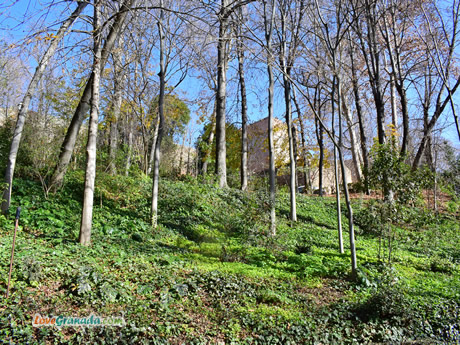 When you pass through the gate, you find yourself in the Alhambra forest (pictured), which surrounds the
the Alhambra Monuments complex.
When you pass through the gate, you find yourself in the Alhambra forest (pictured), which surrounds the
the Alhambra Monuments complex.
From here three paths will lead you into the complex;the lateral ones are for pedestrians only.
They were designed in 1729, although their current configuration dates back to the 19th century.
Now we are in the ancient forest that stretches across the Sabika hill. Right on the top of this hill the Alhambra was constructed.
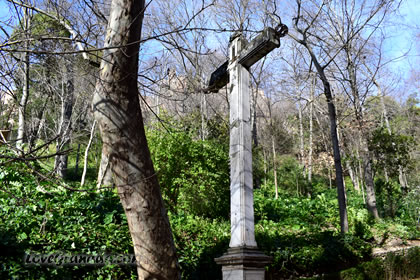 This beautiful forest was planted in the 17th century. Fortunately, it has withstood the test of time and heavy traffic.
Now only authorized vehicles are allowed here.
This beautiful forest was planted in the 17th century. Fortunately, it has withstood the test of time and heavy traffic.
Now only authorized vehicles are allowed here.
This cool and peaceful place still maintains its beauty thanks to the variety of species, primarily chestnuts, poplars, elms, and laurels.
The Fountain of the Gate of the Pomegranates (17th century) and the cross of the gunner Leandro de Palencia (pictured), a former blacksmith of the Alhambra, welcome the visitor.
This fountain was constructed to replace an older one, just like the gate.
The Fountain of Charles V
 If we follow the pedestrian path on the left, we will reach the magnificent Fountain of Charles V (pictured),
a masterpiece of Spanish Renaissance.
If we follow the pedestrian path on the left, we will reach the magnificent Fountain of Charles V (pictured),
a masterpiece of Spanish Renaissance.
In this monumental fountain we can see three large spouts representing the three rivers of Granada: Beyro, Darro and Genil.
Take your time and admire every detail of this marvelous work of art. Once again, right at the top of the fountain, we will find the imperial coat of arms of Charles V.
The Gate of Justice
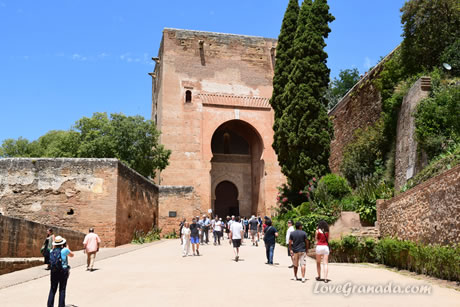 If you pass the fountain and climb the stairs, turning to the left, you will find the marvelous Gate of Justice.
If you pass the fountain and climb the stairs, turning to the left, you will find the marvelous Gate of Justice.
This is one of the four outer gates that provide access to the walled complex of the Alhambra, and certainly the most impressive and renowned. It was built in 1348, during the reign of Yusuf I.
It has two arches, in the outer one you will see a hand carved in stone.
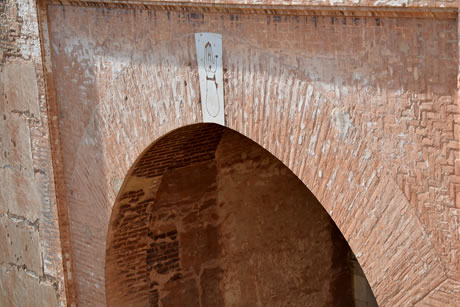 It is the Hand of Fatima or Khamsah, whose five fingers represent the fundamental
principles of Islam: divine unity, prayer, almsgiving, fasting and Pilgrimage
to the Mecca. This Islamic symbol is also used for protection.
It is the Hand of Fatima or Khamsah, whose five fingers represent the fundamental
principles of Islam: divine unity, prayer, almsgiving, fasting and Pilgrimage
to the Mecca. This Islamic symbol is also used for protection.
In the center of the inner arch, you will see a key, which is believed to represent the power that God granted to the Prophet Mohammed to open and close the doors of Heaven.
We pass through this wonderful gate that provides access to the medieval city of the Alhambra.
The Plaza de Los Aljibes
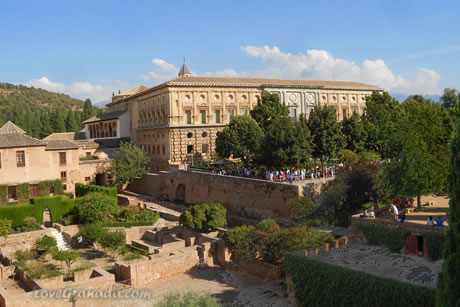 The first thing we find is a large central square called Plaza de Los Aljibes.
It served as a transit point between the military area and the palaces of the Alhambra.
The first thing we find is a large central square called Plaza de Los Aljibes.
It served as a transit point between the military area and the palaces of the Alhambra.
Today it looks very different from the original square. During the Nasrid period, there used to be a significant difference in height here, so the new inhabitants of the Alhambra took advantage of it building a large tank for storing water in 1494.
This is called an "aljibe", hence the name of the place.
 The complex consists of two naves covered with barrel vaults, and there is another water tank
at the north end of the square.
The complex consists of two naves covered with barrel vaults, and there is another water tank
at the north end of the square.
With the construction of the Palace of Charles V (pictured) this area was expanded, and a section of the southern wall was demolished.
Currently, this square serves as the entry point to the Alcazaba and Torre de la Vela (literally Candle Tower).
Here could be a nice spot to pause and take a break during your visit. Enjoy the beautiful views of the Albaycín.
The Gate of Wine
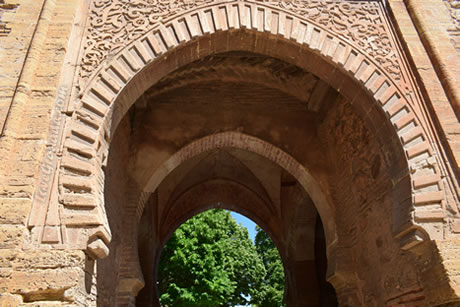 As we return, on the right, we encounter the splendid Gate of Wine (pictured), which served
as the principal entrance to the medina. Let's proceed through it.
As we return, on the right, we encounter the splendid Gate of Wine (pictured), which served
as the principal entrance to the medina. Let's proceed through it.
You will notice that, unlike the outer gates, this one is not built in a L-shaped pattern, and it provides direct access to the artisans' and workers' district.
However, there are benches inside for the guards that controlled the passage.
This gate is one of the oldest buildings in the Alhambra, dating back to the reign of Muhammad III (1302-1309). However, the facades belong to a different period.
Make your experience in Granada even more complete and memorable
10 Best Caves and Venues for Flamenco in Granada: immerse yourself in the passion of flamenco and live unique experiences in the best tablaos in the city.
Authentic Arab Baths and Relaxing Massage: enjoy a deep relaxation experience with an exclusive massage in a traditional setting.
The Palace of Charles V and Museums
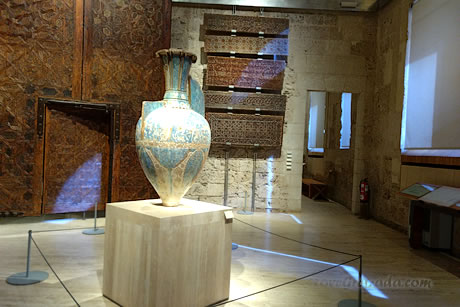 Upon crossing the Gate of Wine, we find ourselves in front of the Palace of Charles V.
Upon crossing the Gate of Wine, we find ourselves in front of the Palace of Charles V.
This exceptional building can be visited free of charge and you will find two museums here:
- the amazing Museum of the Alhambra (pictured) and
- the Museum of Fine Arts (this one is free only for EU citizens).
Church of Santa María de La Encarnacion
You could spend the rest of the day here, but if you wish to continue exploring the treasures of the Alhambra, we recommend you follow the street on the right side of the palace, the Calle Real (Royal Street) and visit the Church of Santa María de La Encarnación (pictured).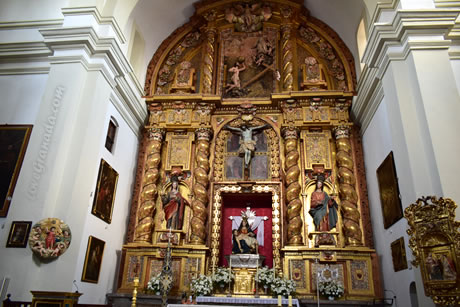 This 17th century church replaced the Great Alhambra Mosque and was built here to symbolize
the triumph of Christianity over Islam.
This 17th century church replaced the Great Alhambra Mosque and was built here to symbolize
the triumph of Christianity over Islam.
The image of Saint Mary of the Alhambra (by Torcuato Ruiz del Peral in 1750 – 1760) is venerated here and taken to Granada every Easter in a very popular procession (photo bellow next to the Gate of Bib-Rambla).
You do not need a ticket to visit this church.
The Saint Francis Convent, Paradores Hotel
If you continue walking this road you will reach the old Saint Francis Convent, turned into a luxury hotel today (National Heritage Paradores group, photo).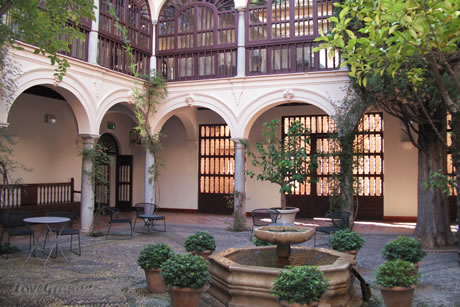 The Palace of Muhammad III (1303-1309) once stood here; however, it was given to the Franciscan
order by the Catholic Monarchs. They wanted to build the first convent of the city here.
It was completed in 1495.
The Palace of Muhammad III (1303-1309) once stood here; however, it was given to the Franciscan
order by the Catholic Monarchs. They wanted to build the first convent of the city here.
It was completed in 1495.
In this convent, Queen Isabella was buried while the Royal Chapel (current burial place) was built.
Its main highlights: the viewpoint that remains from the Nasrid palace and the old chapel, where the Queen was buried.
Angel Barrios Museum and The Gate of the Carriages
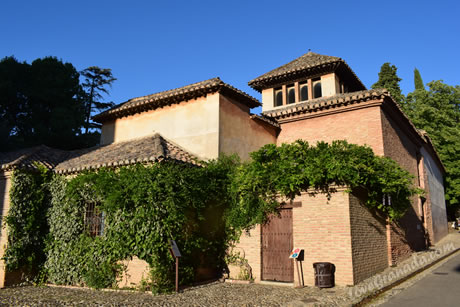 Returning now towards the Palace of Charles V, stop by the Angel
Barrios Museum, a famous musician and composer from Granada.
Returning now towards the Palace of Charles V, stop by the Angel
Barrios Museum, a famous musician and composer from Granada.
This interesting building is located where the Bath of the Great Mosque of the Alhambra once stood. You can see the remains of it and a Nasrid house.
The Barrios family lived here and ran a tavern called "El Polinario", which was the artistic name of the father.
 In fact, Antonio Barrios Tamayo was a prominent flamenco artist, who gathered in his tavern many popular artists,
such as Sorolla, Zuloaga, Ravel and García Lorca.
In fact, Antonio Barrios Tamayo was a prominent flamenco artist, who gathered in his tavern many popular artists,
such as Sorolla, Zuloaga, Ravel and García Lorca.
We continue walking, now turning left and descending towards the forest. We will pass through the Gate of the Carriages (pictured).
This gate was opened in the wall between 1526 and 1536 with the sole purpose of facilitating passage for the construction works in the Palace of Charles V.
The Cuesta de Gomerez and Gate of Bib-Rambla
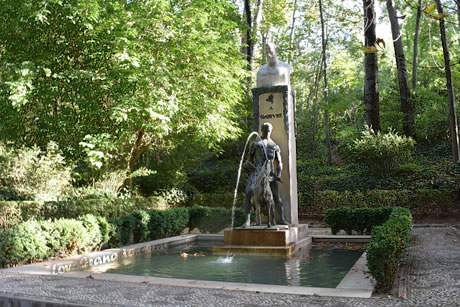 We are back to the same street we climbed before: Cuesta de Gomérez.
We are back to the same street we climbed before: Cuesta de Gomérez.
Here you will find the Monument to Ángel Ganivet, a writer and diplomat from Granada, a key figure in the Generation of 98.
If you walk further down, you will find the marvelous Gate of Bib-Rambla (photo) from the Muslim-medieval era.
Originally it was located in the center of the Nasrid city, in the wall surrounding the medina.
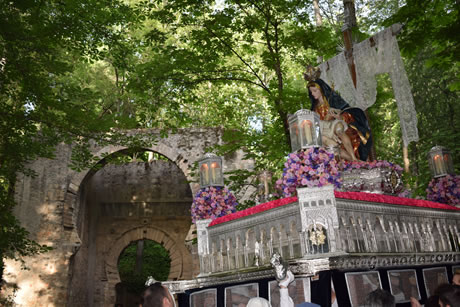 It used to grant access to the square named also Bib-Rambla
until the end of the 19th century.
It used to grant access to the square named also Bib-Rambla
until the end of the 19th century.
Although it was considered a National Monument, it was dismantled in 1894 and moved piece by piece first to the Archaeological Museum, and then here in 1933.
It was also known as the Arch of the Ears and Hands because the ears and hands of convicted offenders were exhibited here.
Carmen de los Mártires
Turning left on this road, we will arrive at the Manuel de Falla Auditorium and the beautiful Carmen de los Mártires (photo). This place was a prison in the Nasrid period and was converted into a convent by the Catholic Monarchs.
This place was a prison in the Nasrid period and was converted into a convent by the Catholic Monarchs.
Today it is a perfect example of the 19th century carmen from Granada, and its beautiful gardens offer amazing views of Granada.
The entrance to the Carmen de los Mártires is free.
Nearby, the Alhambra Palace Hotel has a terrace with panoramic views over the Realejo quarter. This is a great place to enjoy a magical sunset over Granada.
Torres Bermejas
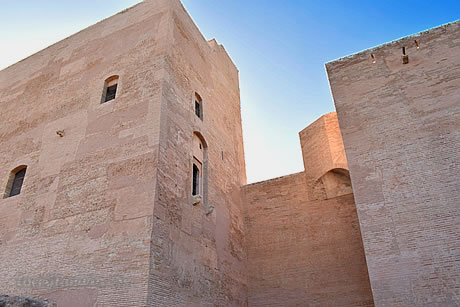 Facing this Hotel, take the main street on your right called Callejón Niño del Royo. You will pass
the Rodríguez Acosta Foundation (pictured)
and at the bottom the Torres Bermejas (Crimson Towers).
Facing this Hotel, take the main street on your right called Callejón Niño del Royo. You will pass
the Rodríguez Acosta Foundation (pictured)
and at the bottom the Torres Bermejas (Crimson Towers).
These watchtowers were built in the 11th century on an earlier fortification to reinforce the walls.
It is believed that the three remaining towers were part of a group that belonged to the first Alcazaba of the Alhambra.
They were located in this strategic point to watch over the Vega of Granada. It was connected with the Alcazaba through a wall.
To see the rest of the Alhambra you have to purchase a ticket.
hear your thoughts.
© Copyright •
LoveGranada.com • Any use of the content, including copying of it in whole or in part is prohibited.
You Might Also Be Interested In
Page Updated: May 14, 2025
Opinions about Alhambra Free Areas
Visiting the Alhambra is more difficult now
Visiting the Alhambra is becoming increasingly difficult. Why are ticket resellers and guided tour portals allowed to hoard tickets and resell them at inflated prices, disguised as so-called 'offers'?
Is it now mandatory to pass through the toll booth of ticket speculation just to access a public cultural site?
This situation is an intolerable abuse that restricts fair access and prioritizes profit over cultural inclusion.
Don't just visit the palaces
Inside the complex, you can walk around the gardens and check out the Carmen de los Martires, which is definitely worth seeing. The Palace of Charles V is interesting, but personally, I think it takes away from the beauty of the Alhambra. And make sure to visit the Parador Hotel, grab a drink and enjoy the lovely courtyard.
Free and paid areas in two days
It is good to visit the free areas on a separate day, there are plenty of things to see. And another day to visit the main sites: Palacios Nasrides, Generalife, Alcazaba, you need a ticket to enter them. If you have only one day in Granada, visit pay areas in the morning and free areas in the evening, after having lunch.


